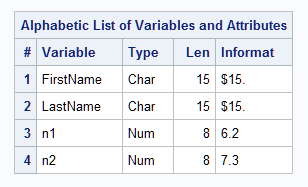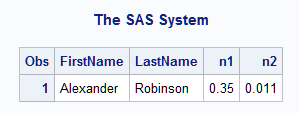INFORMAT Statement
Associates informats with variables.
| Valid in: | DATA step or PROC step |
| Category: | Information |
| Type: | Declarative |
Syntax
Arguments
- variable
-
specifies one or more variables to associate with an informat. You must specify at least one variable when specifying an informat or when including no other arguments. Specifying a variable is optional when using a DEFAULT= informat specification.Tip:To disassociate an informat from a variable, use the variable's name in an INFORMAT statement without specifying an informat. Place the INFORMAT statement after the SET statement. See Removing an Informat.
- informat
-
specifies the informat for reading the values of the variables that are listed in the INFORMAT statement.Tip:If an informat is associated with a variable by using the INFORMAT statement, and that same informat is not associated with that same variable in the INPUT statement, then that informat will behave like informats that you specify with a colon (:) modifier in an INPUT statement. SAS reads the variables by using list input with an informat. For example, you can use the : modifier with an informat to read character values that are longer than eight bytes, or numeric values that contain nonstandard values. For details, see INPUT Statement, List.
- DEFAULT= default-informat
-
specifies a temporary default informat for reading values of the variables that are listed in the INFORMAT statement. If no variable is specified, then the DEFAULT= informat specification applies a temporary default informat for reading values of all the variables of that type included in the DATA step. Numeric informats are applied to numeric variables, and character informats are applied to character variables. These default informats apply only to the current DATA step.Default:If you omit DEFAULT=, SAS uses w.d as the default numeric informat and $w. as the default character informat.Restriction:Use this argument only in a DATA step.Tip:A DEFAULT= specification can occur anywhere in an INFORMAT statement. It can specify either a numeric default, a character default, or both.Example:Specifying Default Informats
Details
The Basics
An INFORMAT statement
in a DATA step permanently associates an informat with a variable.
You can specify standard SAS informats or user-written informats,
previously defined in PROC FORMAT. A single INFORMAT statement can
associate the same informat with several variables, or it can associate
different informats with different variables. If a variable appears
in multiple INFORMAT statements, SAS uses the informat that is assigned
last.
How SAS Treats Variables When You Assign Informats with the INFORMAT Statement
Comparisons
-
Both the ATTRIB and INFORMAT statements can associate informats with variables, and both statements can change the informat that is associated with a variable. You can also use the INFORMAT statement in PROC DATASETS to change or remove the informat that is associated with a variable. The SAS windowing environment enables you to associate, change, or disassociate informats and variables in existing SAS data sets.
-
SAS changes the descriptor information of the SAS data set that contains the variable. You can use an INFORMAT statement in some PROC steps, but the rules are different. For more information, see FORMAT Procedure in Base SAS Procedures Guide.
Examples
Example 1: Specifying Default Informats
Example 2: Specifying Numeric and Character Informats
This example associates
a character informat and a numeric informat with SAS variables. Although
the character variables do not fully occupy 15 column positions, the
INPUT statement reads the data records correctly by using modified
list input:
data name; informat FirstName LastName $15. n1 6.2 n2 7.3; input firstname lastname n1 n2; datalines; Alexander Robinson 35 11 ; proc contents data=name; run; proc print data=name; run;

